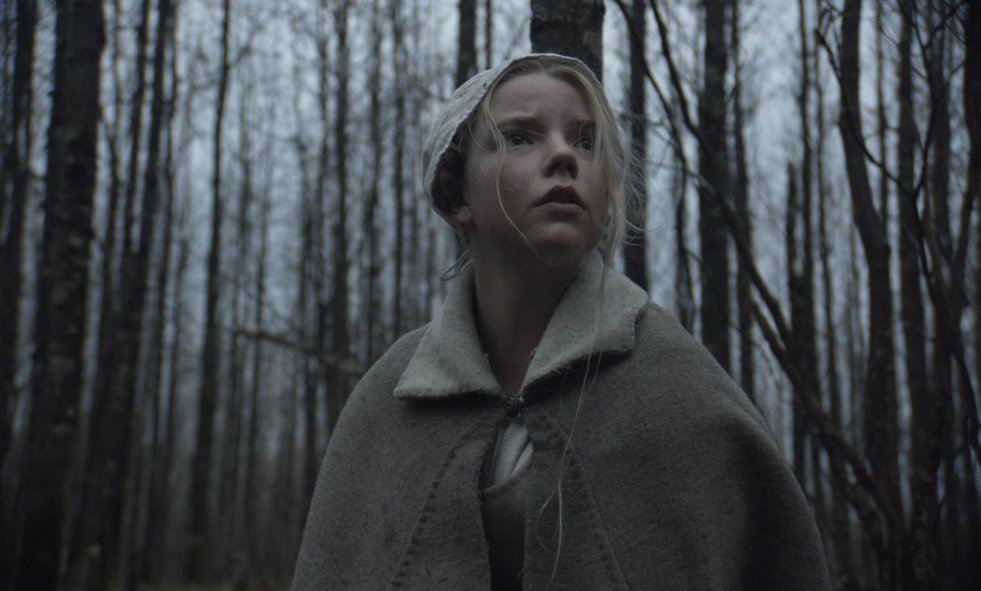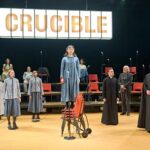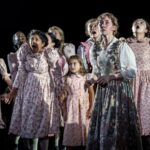Joyce Glasser reviews The Witch (March 12, 2016)
The advice given to first time filmmakers is to write about yourself and what you know. Robert Egger’s feature film debut, The Witch, is ‘A New-England folk tale,’ about an English pilgrim family living on a secluded farm in New England 1630.
Behind the farm is the forest primeval where evil lurks in countless folk and fairy tales. And, we can add: horror movies. While it may seem that nothing could be further from the life of a young writer/director living in NYC, 2016, Eggers explains: “I’m from New England and for whatever reasons as a kid, New England’s history and past was part of my consciousness.” 
Unlike Arthur Miller, who used the 1692 Salem witch hunts and trials as an allegory for McCarthyism (the Communist witch hunts of the 1950s) in The Crucible, Eggers aims to dispel allegory or contemporary associations. He uses every technique he can muster to immerse us in the lives and in the minds of a devoutly religious 17th century puritan family 60 years before the trials began. While the ending feels out of place, The Witch is one of the most original, and watchable, horror films in years.
It is evident from their heavy Yorkshire accents that the bearded, tall and gaunt father named William (Ralph Ineson) and his wife Katherine (Kate Dickie) have already been exiled from their native England. When the film opens, they are being exiled a second time by a grim New England colony council for the crime of ‘prideful conceit’. William loads the family’s belongings into a rickety open carriage drawn by their only horse, and eventually builds a farm on the edge of a forest.
The failure of the first harvest is one of many events William can blame on his lack of sufficient faith. The prayers intensify. Thankfully, the four children are healthy and Katherine has recently given birth to a healthy fifth child, a son named Samuel.
Katherine forbids her children from venturing into the forest, but one day William takes his eldest son, Caleb (Harvey Scrimshaw), with him to check the traps for food.
They see a large rabbit which, like the black ram they keep in the farmyard, is associated in our psyches and folklore with witchcraft.
William fires at the rabbit, but the gunpowder backfires, temporarily burning his eyes, while the rabbit runs away.
Caleb is just old enough to be fascinated by his beautiful, pubescent, older sister Thomasin’s (Anya Taylor-Joy) bosom, but innocent enough to feel guilty about his attraction. He tells his father , ‘My corrupt nature is empty of grace, bent unto sin.’ In the rustic, open plan house, where everything is heard, even the six-year-old twins hear and ingest their parents’ fears, contrition and litany of sins.
One day, Thomasin is playing peek-a-boo with Samuel, who lies right beneath her on a blanket in the yard between the house and the forest. The infant smiles with pleasure each time she hides her eyes and then drops her hands. When she opens her eyes for the third time, however, Samuel is gone. Thomasin races into the woods, where we think we are seeing a woman’s shape carving the infant with a knife.
Caleb’s reaction is telling. ‘I would tell you that Sam sleeps with Jesus, but I do not know’, he tells his father. Even an infant, it seems can be corrupted by the devil.
As they mourn the loss of Samuel, a series of sinister events occur. While the loss of the precious horse is only too real, our ability to distinguish between what is real and what the family’s warped minds imagine, becomes blurred.
A crow pecking at Katherine’s breast where Samuel once drank milk is a nightmare, but when Katherine awakens, there is blood on her nightgown. Thomasin and Caleb do, in reality, head into the forest like Hansel and Gretel, but when Caleb comes across a cottage where a voluptuous woman beckons, is he really seduced or is it a young boy’s fantasy?
Original as it is, Egger’s film is punctuated by film references, and these are intentional. The most obvious is Stanley Kubrick’s adaptation of Stephen King’s The Shining, in which a father uproots his family and moves it to a remote hotel in the mountains of Colorado. The father becomes controlled by an evil ghost putting his family in danger.
The film’s distinctive dialogue and attitudes come from original documents of the period. Eggers studied the accounts of the Salem witch trials documented by such people as Cotton Mather, the minister responsible for laying the groundwork of the trials.
 A designer before turning to directing, Egger also modeled his convincing costumes and sets on those available at the Plimouth Living Museum in Plymouth, Massachusetts, one of the original Pilgrim settlements.
A designer before turning to directing, Egger also modeled his convincing costumes and sets on those available at the Plimouth Living Museum in Plymouth, Massachusetts, one of the original Pilgrim settlements.
Alfred Hitchcock claimed that he did not shoot Psycho in colour because he did not want to show the red blood against the white shower. Here, the hand-crafted, off-white coarse smocks and nightgowns show the blood only too well. The atmosphere is so real that we share the tragic family’s terror as well as their pain and doubt as they embark on their own internal witch hunt.
With all the meticulous research, it is odd that Eggers cast a group of children who, while resembling one another physically, with their button noses and round faces, look nothing at all like their parents, both of whom have angular faces and distinctively prominent noses.
A bigger problem is the ending. Despite following a particularly violent and gruesome series of events, Eggers feels the need to deliver an explicit, explosive set piece that, with its Ken Russell gothic excess, tends to destroy the admirable ambiguity of the film.
While Eggers manages to avoid the allegory that was Arthur Miller’s raison d’être, audiences will automatically attach a metaphorical significance to the way in which the beleaguered family’s real enemy might be their fundamentalist religious fervour.




